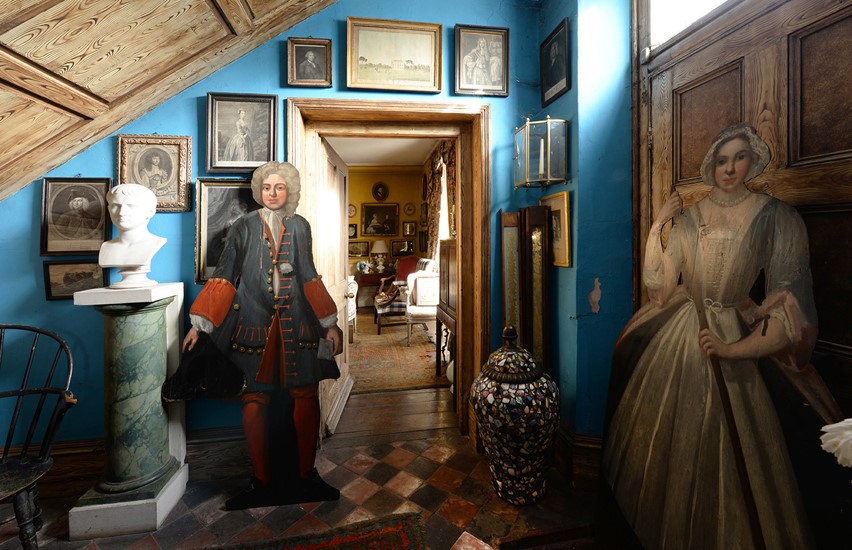Auction Insights
The Harold Ward Collection

As one man’s collection of thousands of antiques and bygones are about to go under the hammer Nigel Kirk reflects on some highlights
Auction watchers not infrequently bemoan how seldom there is a good, old fashioned ‘single-owner’ Sale. They are in for a treat on February 6 & 7 when the Harold Ward Collection goes under the hammer at Mellors & Kirk.
There is a plethora of 18th century portraits of men and women, furniture of the same period, old copper and brass kitchenalia, lighting, boxes, objects and Georgian odds and ends of every description as befitted Harold’s Grantham home. But there is much more to the collection than that.
Harold’s approach to a lifetime of collecting was not that of a specialist in one field but rather that of an antiquarian – he loved anything that was genuinely of the 18th century – or the early 19th - better still, if it was even remotely connected with the one figure that interested him more than anything else, Lord Byron.
Not the poet’s books but objects and pictures that were in some way personal to the man and his closest family were what he spent decades pursuing. Some of these fascinating artefacts will be the subject of next week’s Under the Hammer.
The overgrown-cottage that was Harold’s home, Manthorpe House, facing a busy road junction on the outskirts of Grantham, presented no clue from the slightly shabby exterior as to what it contained. Rarely have I seen so crowded and theatrical a mise en scène, of collections within collections, everything from hundreds of 18th century engravings and silhouettes to three startling painted wood ‘dummy boards’. They are life size painted effigies that the fashion conscious but companionable Georgians placed in their rooms on a whim.
I couldn’t help thinking of them when I heard of a Japanese artificial intelligence company’s robot ‘pets’ that were such a talking point at CES, the world’s biggest tech fair in Las Vegas, earlier this month.
One of the many eclectic objects is a Chinese ‘Nanking’ blue and white china chamber pot. Made in about 1770, the interior is rudely and bizarrely painted with an eye! Definitely a ‘bygone’ is the 17th century or earlier iron key to Carlisle Castle. At 24cm long it is a key that is hard to lose. There is bound to be enormous interest in one of the rarest items, an oval portrait of Captain George Delanoe of the Royal Navy. The poor Captain lost a leg in a mutiny, the famous ‘Battle of the Nore’. He had earlier had his portrait painted in Guangzhou (at that time known as Canton) in China. The artist is known only by his somewhat unfortunate anglicised name of ‘Spoilum’ and was the first Chinese painter to adopt western techniques for example using oil on a type of cheesecloth canvas, and his minutely detailed pictures are a strange combination of Eastern and Western styles. One lot in the Sale that could well stand for everything that is of interest in the whole collection is a small 1788 hand coloured engraving by publisher Robert Sayer. Titled “Obadiah and the Pretty Milliner”, for me in a few square inches it seems to encapsulate Georgian England.
A ‘regular’ at some of the grandest country house auctions of the 1960s & 70s he bought at such important sales as those of the contents of the Chaworth Musters family home, Annesley Hall and the Edge family’s Strelley Hall, Nottingham.
Unusually the entire contents of Harold’s house is being sold at auction because it contains nothing modern, in the sense of being second-hand and he expressed the wish that others should one day have the opportunity to acquire objects that have fascinated him for so many years.
An interest in collecting antiques often leads to dealing and as a young man in the late 1950s Harold dealt in antiques at Chelmsford before moving into Manthorpe House in 1968. Unlike many people he had no interest in modernising the property which is why I described it recently as a “house where time has stood still”. His keen eye for decoration was evident in every room. I was especially struck by the bright blue hall, a true 18th century colour long before some well-known companies ‘heritage’ paint was thought of.
In the 18th century pictures were closely hung and entire ‘print rooms’ would be dedicated to the display of carefully grouped portrait engravings and caricatures. Harold had the same idea, hanging dozens of 18th century mezzotints and other prints throughout the hall, up the stairs and along the landings. Before anything was disturbed Mellors & Kirk had everything photographed in situ as a record of a vanished era of antique collecting, especially the 1960s, the period of Arthur Negus, first of all the popular tv antiques pundits.
The catalogue of the Harold Ward Collection goes online on Thursday 24 January and large numbers are expected to view the Sale when the exhibition opens on Sunday 3 February.
< Back to Auction Insights




